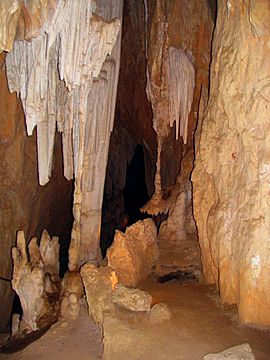Wombeyan Caves facts for kids
Quick facts for kids Wombeyan Karst Conservation ReserveNew South Wales |
|
|---|---|

Fig Tree Cave interior
|
|
| Nearest town or city | Taralga |
| Population | 57 (2016 census) |
| • Density | 10.04/km2 (26.0/sq mi) |
| Established | December 1997 |
| Area | 5.68 km2 (2.2 sq mi) |
| Managing authorities | NSW National Parks & Wildlife Service |
| Website | Wombeyan Karst Conservation Reserve |
The Wombeyan Caves are amazing caves found in marble rock. They are located in the Wombeyan Karst Conservation Reserve in New South Wales, Australia. This area is a popular spot for tourists and holidays. It's also a special home for animals like wallabies, birds, possums, and wombats that need protection.
Contents
Where are the Wombeyan Caves?
The Wombeyan Caves are in the Southern Highlands. This is about 77 kilometers (48 miles) north of Goulburn. You can get there by taking the Wombeyan Caves Road. This road starts from either Mittagong in the east or the Goulburn-Oberon Road in the west. The cave reserve is closer to the western end of Wombeyan Caves Road. The road from the east is quite bumpy and winding. It goes down to the Wollondilly River and then up steep mountains. The views along this road are truly spectacular!
History of the Wombeyan Caves
Indigenous History and Stories
The Wombeyan Caves are on the traditional lands of the Burra Burra clan. This clan is part of the Gandangara people. They have lived in this area for a very long time. Scientists have found tools from 6,000 to 14,000 years ago. These tools show that Indigenous people used the land around the caves.
The name Wombeyan likely comes from the Ngunnawal language. It might mean 'tunnel'. This refers to a Dreamtime story about a rainbow serpent named Gurangatch. In the story, Gurangatch created a tunnel. An early writer, Robert Hamilton Mathews, recorded this story. He wrote that Gurangatch "burrowed under the range, coming up inside of Wam-bee-ang caves." People have looked for this tunnel but haven't found it. The name has been spelled in many ways over time.
Naming the Caves
Charles Chalker was the first government caretaker of the caves. He gave many of the individual caverns Gandangara names. These names include ‘Wollondilly’, ‘Mulwaree’, ‘Guineacor’, ‘Bullio’, ‘Kooringa’, and ‘Miranda’. The first three are names of local rivers. Bullio is a nearby place. ‘Kooringa’ might be another local place name. ‘Miranda’ was named after Murrandah, a leader of the Burra Burra clan.
What Can You Do at Wombeyan Caves?
The Wombeyan Caves area became a protected reserve in 1865. Today, it has many facilities for visitors.
- There are several camping grounds where you can stay.
- You can find a kiosk to buy snacks and drinks.
- There's a public phone and a kitchen for visitors to use.
- A ranger station is also near the camping area. Rangers help visitors and protect the plants and animals. They collect camping fees and answer questions.
Exploring the Caves
Many different caves are found in this reserve.
- The Victoria Arch is very popular. It's close to the camping grounds.
- The Fig Tree Cave is another famous one.
- Other caves include Junction, Wollondilly, Mulwaree, and Kooringa caves.
- Official caving groups often visit Wombeyan Caves. They get special permits for their expeditions.
Other Interesting Spots
Besides the caves, there are other cool places to see.
- You can explore the creek and a beautiful waterfall.
- There are also smaller caves hidden in the large forest area.
Wildlife at Wombeyan Caves
The Wombeyan Karst Conservation Reserve is a safe place for many animals. It protects endangered species like wallabies, birds, possums, and wombats.
While there are rules about interacting with wildlife, some animals are becoming very comfortable around people.
- Many birds, like magpies and Indian mynahs, often come very close to campers. They sometimes ask for food!
- Other birds, such as satin bowerbirds, currawongs, and rosellas, are also seen near the caves.
- The many kangaroos are also getting used to people. They often come within a few meters of campsites without fear.
It's exciting for visitors to see these animals up close. However, park rangers are careful. They want to make sure the animals stay wild and healthy in the long term.


